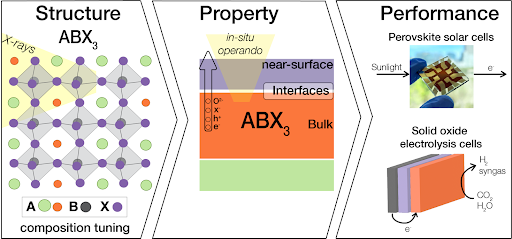Structure-property relationships in perovskites for energy conversion: From mechanisms to advancing sustainable energy materials

Speaker
Juanita Hidalgo
School of Engineering Distinguished Postdoctoral Fellow
Massachusetts Institute of Technology
Abstract
Structure-property relationships in perovskites for energy conversion: From mechanisms to advancing sustainable energy materials
Developing new energy conversion technologies is a major scientific challenge to tackle global warming and meeting energy demands. Perovskite materials (ABX3) are promising to address these issues due to their compositional flexibility, tunable properties, and structural variety. Perovskites can function as electron and/or ion conductors, key in energy applications such as photovoltaics, fuel cells, and electrolysis cells. Lead halide perovskites have been used as absorber layers in high-efficiency, low-cost solar cells. Perovskite oxides have been used as electrodes and catalysts in solid oxide fuel and electrolysis cells. However, the perovskite crystal structure can be unstable, often transforming into other phases when exposed to various external stressors. This instability can negatively impact lead halide perovskites, but it can be advantageous for the formation of metal nanoparticles in perovskite oxides. My work utilizes advanced synchrotron-based in-situ and surface-sensitive techniques, such as grazing-incidence wide-angle X-ray scattering and X-ray photoelectron spectroscopy, to investigate the structural and chemical properties of these materials to enhance their performance in devices. First, I will address the challenge of instability in lead halide perovskites when exposed to external factors such as humidity, as this poses a significant barrier to their commercialization. Second, I will discuss the high-temperature reduction of nickel titanate perovskite oxides, which can lead to phase transformations and the formation of embedded nanoparticles through a process called exsolution. Nickel nanoparticles are effective catalysts for electrochemical reactions that are relevant to energy conversion and storage systems. By understanding the mechanisms behind perovskite phase transformations and establishing correlations between structure, chemistry, and properties, we can optimize these materials to enhance their stability and efficiency for practical energy applications.

Bio
Juanita Hidalgo is a Postdoctoral Fellow of Engineering Excellence at the Massachusetts Institute of Technology (MIT) whose research has focused on materials for photovoltaic and other energy conversion applications. She obtained her B.S. in Chemical Engineering from Universidad de los Andes, Colombia. In 2023, she completed her Ph.D. in Materials Science and Engineering at the Georgia Institute of Technology. As a doctoral candidate in Professor Correa-Baena’s group, Dr. Hidalgo developed expertise in understanding structure-property relationships of lead halide perovskites for solar cells using various synchrotron-based X-ray techniques. Her thesis was recognized with the Julian Baumert Thesis Award from the National Synchrotron Light Source II at Brookhaven National Lab. Currently, in Professor Bilge Yildiz’s group at MIT, Dr. Hidalgo is applying her expertise in X-ray characterization to investigate the formation of metal catalyst nanoparticles in perovskite oxides to enhance the performance of solid-oxide electrolysis cells used in decarbonization processes.


